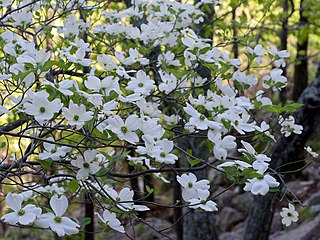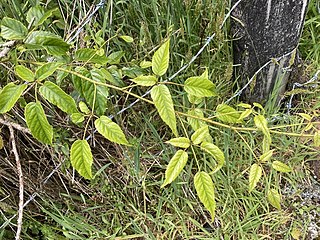
A vine is any plant with a growth habit of trailing or scandent stems, lianas or runners. The word vine can also refer to such stems or runners themselves, for instance, when used in wicker work.

Cornus florida, the flowering dogwood, is a species of flowering tree in the family Cornaceae native to eastern North America and northern Mexico. An endemic population once spanned from southernmost coastal Maine south to northern Florida and west to the Mississippi River. The tree is commonly planted as an ornamental in residential and public areas because of its showy bracts and interesting bark structure.

Strongylodon macrobotrys, commonly known as jade vine, emerald vine or turquoise jade vine, is a species of leguminous perennial liana endemic to the tropical forests of the Philippines. Its local name is tayabak. A member of the Fabaceae, it is closely related to beans such as kidney bean and runner bean. Strongylodon macrobotrys is pollinated by bats.

Mulanay, officially the Municipality of Mulanay, is a 1st class municipality in the province of Quezon, Philippines. According to the 2020 census, it has a population of 55,576 people.

Vitis riparia Michx, with common names riverbank grape or frost grape, is a vine indigenous to North America. As a climbing or trailing vine, it is widely distributed across central and eastern Canada and the central and northeastern parts of the United States, from Quebec to Texas, and eastern Montana to Nova Scotia. There are reports of isolated populations in the northwestern USA, but these are probably naturalized. It is long-lived and capable of reaching into the upper canopy of the tallest trees. It produces dark fruit that are appealing to both birds and people, and has been used extensively in commercial viticulture as grafted rootstock and in hybrid grape breeding programs.

Parthenocissus inserta, also known as thicket creeper, false Virginia creeper, woodbine, or grape woodbine, is a woody vine native to North America, in southeastern Canada and a large area of the United States, from Maine west to Montana and south to New Jersey and Missouri in the east, and Texas to Arizona in the west. It is present in California, but it may be an introduced species that far west. It is introduced in Europe.

Bartlettina sordida, the purple torch or blue mist flower, is a flowering plant which is endemic to cloud forest habitats in Mexico. It was formerly classified in the genus Eupatorium.

Metrosideros fulgens is a forest liana or vine endemic to New Zealand. It occurs in coastal and lowland forest throughout the North Island, on the west coast of the South Island and on the Three Kings Islands north of Cape Reinga. It is one of a number of New Zealand Metrosideros species which live out their lives as vines, unlike the northern rata (M.robusta), which generally begins as a hemi-epiphyte and grows into a huge tree. Scarlet rātā is one of the better-known species of rātā vines, because it flowers in autumn or winter, and is often highly visible on well-lit host trees along forest roads, with vibrant displays of large red flowers that rise above the forest canopy.

Stephanotis floribunda syn. S. jasminoides, the Madagascar jasmine, waxflower, Hawaiian wedding flower, or bridal wreath is a species of flowering plant in the family Apocynaceae, native to Madagascar. It is a twining, sparsely branched liana that can measure up to 6 m in length.

Strongylodon is a genus of flowering plants in the legume family, Fabaceae. It belongs to the subfamily Faboideae. The most well-known species of this genus is Strongylodon macrobotrys, also known as jade vine.

Rubus cissoides, commonly called bush lawyer or tātarāmoa in te reo Māori, is a species of flowering plant in the family Rosaceae, endemic to New Zealand. Alan Cunningham described R. cissoides in 1839. Plants of this species of are perennial scrambling vines with compound leaves with 3-5 leaflets each up to 15 cm long, reddish prickles on the branches, white flowers from September to November and red berries from December to April. The conservation status of R. cissoides is Not Threatened, it is widespread on all three main islands of mainland New Zealand, and it has been used by Māori as food, medicines and construction materials.

Aristolochia praevenosa, synonym Pararistolochia praevenosa, is an Australian plant in the birthwort family, native to Queensland and New South Wales. The Richmond birdwing butterfly vine grows in subtropical rainforest in coastal areas north from Wollongbar, in far north eastern New South Wales and adjacent areas in south eastern Queensland. It has been recorded as far north as the Mary River. It also grows in tropical north eastern Queensland, where it is a food plant for the Cairns birdwing butterfly.

Nepenthes leonardoi is a tropical pitcher plant known from a single locality in central Palawan, the Philippines. It is closely allied to several other Palawan endemics, including N. deaniana, N. gantungensis, and N. mira. The traps of this species reach at least 24 cm in height. Some specimens are noted for producing very dark, almost black, upper pitchers.
The Buenavista Protected Landscape is a conservation area and an archaeological site located on Bondoc Peninsula in the southern Luzon province of Quezon in the Philippines. It conserves an important watershed area composed of secondary-growth forest, grassland and coconut land in the rural village of Buenavista within the coastal municipality of Mulanay. The area was primarily set aside for watershed protection and timber production in 1937 covering approximately 356 hectares. In 2000, it was reestablished as a protected landscape area under the National Integrated Protected Areas System. The area is known as the site of an ancient village containing unique limestone graves discovered in 2011. The protected area, including the limestone tombs of Kamhantik were recommended by various scholars to be included in the tentative list of UNESCO World Heritage Sites, yet no government or private entities have yet to file a tentative nomination to the UNESCO Secretariat.

The Limestone Tombs of Kamhantik is an excavated remains of a thousand-year-old barangay found in the jungles of Mount Maclayao in Sitio Kamhantik within the Buenavista Protected Landscape of Mulanay, Quezon, Philippines. It is widely believed that pre-colonial Tagalog people were responsible for the creation of the tombs.

Ampelopsis glandulosa, with common names creeper, porcelain berry, Amur peppervine, and wild grape, is an ornamental plant, native to temperate areas of Asia including China, Japan, India, Nepal, Myanmar, Vietnam, and the Philippines. It is generally similar to, and potentially confused with, grape species and other Ampelopsis species.

Pararistolochia enricoi is an endemic Malagasy species of plant in the birthwort family, the only belonging to the genus Pararistolochia within the Island.

Mucuna gigantea is a species of large woody climber from the family Fabaceae. It is found in sub-Saharan Africa, India, tropical southern Asia, the Philippines, New Guinea and parts of Australia, and is commonly known as sea bean or burny bean.

Solanum pachyandrum, known as bombona, is a spine-forming vine of the Solanum genus. It is native to southwestern Ecuador and northwestern Peru where the large juicy fruit is commonly eaten and considered a treat by children. Although the plant has been known and consumed by the indigenous people of that land, it was only published scientifically in 1914 by German botanist Friedrich August Georg Bitter.
Purple jade vine can refer to:


















